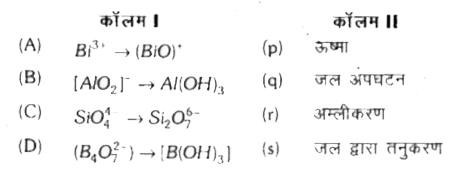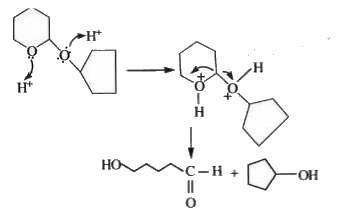In the given reaction
 Solution in Telugu
Solution in Telugu



all of these
The correct Answer is:C
Topper's Solved these Questions
- BOOK - AAKASH SERIESCHAPTER - ALDEHYDES AND KETONESEXERCISE - LEVEL-II LECTURE SHEET (EXERCISE-II)28videos
ALDEHYDES AND KETONES
- BOOK - AAKASH SERIESCHAPTER - ALDEHYDES AND KETONESEXERCISE - LEVEL-II LECTURE SHEET (EXERCISE-III)11videos
ALDEHYDES AND KETONES
- BOOK - AAKASH SERIESCHAPTER - ALDEHYDES AND KETONESEXERCISE - LEVEL-I(EXERCISE-II)59videos
ALDEHYDES AND KETONES
- BOOK - AAKASH SERIESCHAPTER - ALCOHOLS, PHENOLS AND ETHERSEXERCISE - ETHERS (OBJECTIVE EXERCISE-4)50videos
ALCOHOLS, PHENOLS AND ETHERS
- BOOK - AAKASH SERIESCHAPTER - ALKYL AND ARYL HALIDESEXERCISE - OBJECTIVE EXERCISE - 4 (ASSERTION (A) & REASON (R) TYPE QUESTIONS)19videos
ALKYL AND ARYL HALIDES
Similar Questions
Which of the following give N- subtituted amide from ketoxime ?
09:56View SolutionAldehydes and ketons are susceptible to nuclephlic addition because carbonylgroup

Polar (due to electronegativeity difference between carbon and oxygen
positive charge on carbonyl compound towards nucleophilic . this addition is catalysed by acid . REactivity of carbonyl compound towards nuclephilic addotion increase with increase in teh electron deficiency at carbonyl carbon Thus (-I.E ) groups increase while (+I.E ) groups decreases the reactivity of carbonyl compound .
which among the following is most reactive towards nuclephilic additionView SolutionEthylene is converted to X on passing through a mixture of an acidified aqueous solution of palladium chloride and cupric chloride. Which of the following reagents readily take part in addition reaction with X ?
05:12View Solution(A): Alcoholic fermentation involves conversion of sugar into ethanol by the action of yeast.
(R): Fermentation involves the liberation of CO2 gas.04:02View Solution(A) Towards SN2 reaction, order of reactivity is CH3Br>CH3CH2Br>(CH3)2CHBr>(CH3)3CBr.
(R) Greater the stability of carbocation, greater will be its ease of formation from alkyl halide and faster will be the rate of SN1 reaction.01:56View SolutionMatch the reactions given in Column I with the type of reactions given in Column II
View SolutionMatch the reactions given in column I with the types of reactions given in column II.
 .09:56View Solution
.09:56View SolutionThe reaction given
 is : View Solution
is : View SolutionMatch the following reactions given in Group 'A' with the observations of reaction given in Group 'B'
 04:27View Solution
04:27View SolutionGiven reaction Y in the reaction is
04:39View SolutionMatch the reactions given in Column I with the types of reactions given in Column II.
02:59View SolutionMatch the reactions given in Column I with the types of reactions given in Column II.
01:25View SolutionThe reaction of the given reaction is:
06:58View Solutionकॉलम I में दी गई अभिक्रियाओं को कॉलम II में दी गई अभिक्रियाओं की प्रकृति के साथ सुमेल कीजिए।
 03:33View Solution
03:33View SolutionMatch the reactions given in Column - I with the types of reactions given in Column - II.
 01:27View Solution
01:27View SolutionMatch the reactions given in Column I with the type of reactions given in Column II
View Solution


